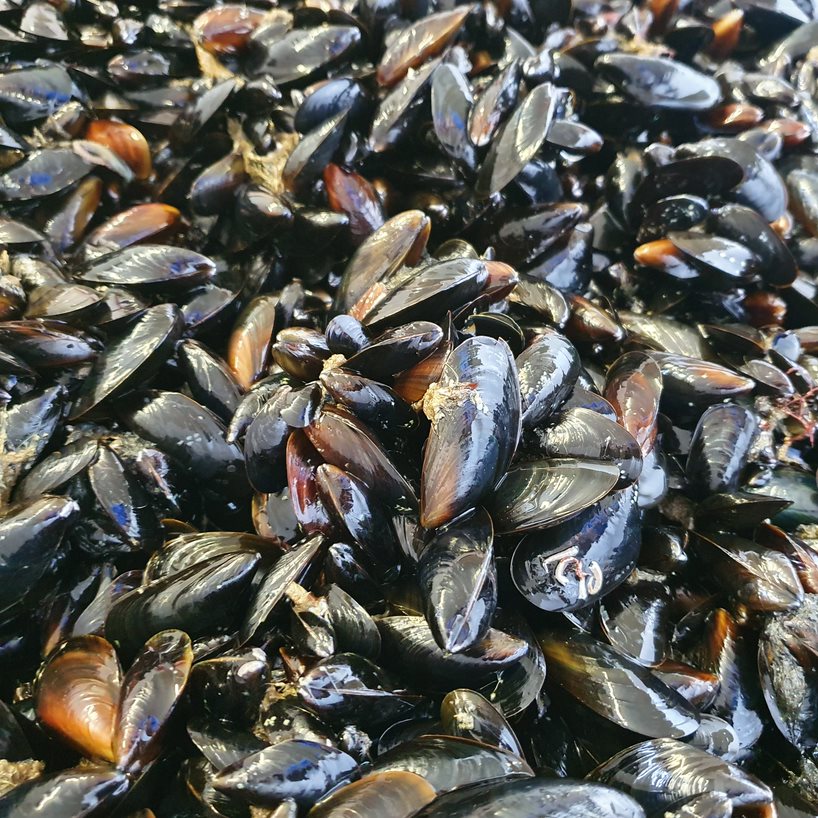The blue mussel is in fact very common in Nordic seawaters. Now it will be used in a project as a novel ingredient in chicken feed. But why exactly is it an attractive feed ingredient?
It is a natural cleaner
The blue mussel is part of the ocean`s cleaning staff. It eats phytoplankton and other organic components filtered from the water, and a fully grown mussel can filter several litres of water per hour. More specifically, the blue mussel efficiently absorbs and capture nitrogen, carbon, and phosphorus. In fact, every 1000 ton of raw mussel can remove 143 ton of nitrogen and 1,15 ton of phosphorus in the sea.

Our neighbour, Denmark, use farmed blue mussels to clean the ocean by capturing phosphorus and nitrogen originated from agriculture. Mussel farming has a confirmed positive effect on marine environments through carbon fixation and nutrient removal from water.
Blue Mussels. Photo: Ocean Forest
However, since the shells used in Denmark are not suitable for human consumption, this often goes to waste. This is where the project BlueMusselFeed comes along.
A good protein source
In addition to being a natural cleaner, blue mussels are an excellent protein and fatty acid resource with good technical qualities. The project BlueMusselFeed aim to make Nordic poultry feed from ocean cleaning blue mussels. Today much of the feed ingredients are imported, and the thought is that blue mussels can replace imported soy, corn-gluten and fish protein.
By utilizing wasted mussels from Denmark, it can be used to kick start our own blue mussel industry in Norway. Using mussels in animal feed will recycle the absorbed nutrients back in our food chain, and by replacing imported feed ingredients it can reduce climate emissions from Norwegian poultry.
Prior research has already demonstrated that blue mussels can be used as a feed ingredient in poultry, pigs, and salmon. A fun fact is that blue mussels also contain pigments which can give a yellow colour, for example nice and yellow egg yolks. Potential benefits of the ingredient will be exposed during the process, but the main goal is to confirm that blue mussels can be as good as the existing imported ingredients.
The challenges with blue mussels
There are some barriers when it comes to utilizing blue mussel as a novel feed ingredient. For example, separation of the mussel fractions is yet to be improved, because many of the existing techniques are energy demanding. The mussel is also highly perishable. Consequently, pre-processing and processing must take place shortly after harvesting.
However, since BlueMusselFeed is a collaborative project, the different actors can contribute with their knowledge and experience. Project Developer at Land meets Ocean, Elise Sæle Dahle, says cooperation is a strength when facing challenges.
– This project is a great example of how we can solve complex issues through collaboration across blue and green sector. By joining forces, we reduce the risk and increase the likelihood of success, says Elise Sæle Dahle, Project Developer, Land meets Ocean.
About the project
BlueMusselFeed originates from the collaboration Land Meets Ocean. It is financed by Innovation Norway and a crossover project between NCE Seafood Innovation, NCE Blue Legasea, Biotech North and NCE Heidner Biocluster. The industry partners in this project are Fiskå Mølle, Lerøy Ocean Forest, Eide Fjordbruk, Norforsk, Animalia and Nortura.
The goal is to increase Norway’s self-sufficiency in food production by harvesting and circulating resources from aquaculture. The project just got 11 million in funds from the Research Council of Norway.
Sources
https://www.hi.no/hi/temasider/arter/blaskjell
Timmermann, K., Maar, M., Bolding, K., Larsen, J., Windolf, J., Nielsen, P., & Petersen, J. K. (2019). Mussel production as a nutrient mitigation tool for improving marine water quality. Aquaculture Environment Interactions, 11, 191–204
van der Heide, M. E, Johansen, N. F., Kidmose, U., Nørgaard, J. V., & Hammershøj, M. (2021). The effect of deshelled and shell-reduced mussel meal on egg quality parameters of organic laying hens under commercial conditions. Journal of Applied Poultry Research, 30(1), 100119.
Waldenstedt & Jönsson (2006) Mussel meal as a high quality protein source for broiler chickens. . 12th European Poultry Conference,Verona, Italy 10-14 September 2006
Nagelsen (2021) Skal finne ut om blåskjell er en god proteinkilde i fôr
Read more: